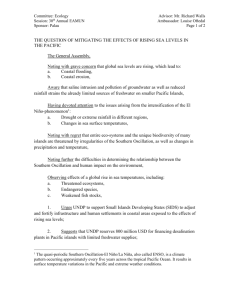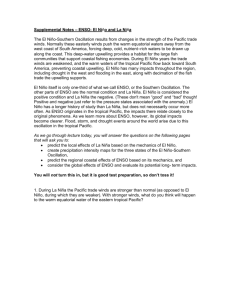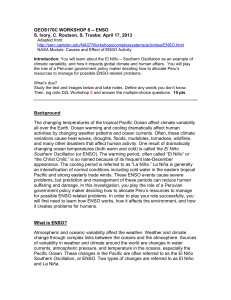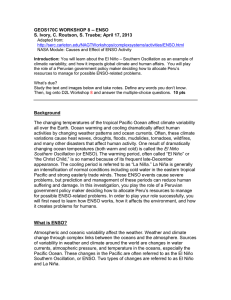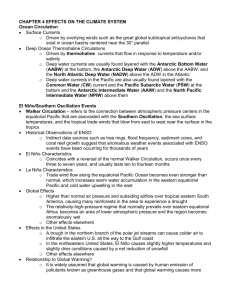Corey Gabriel
advertisement
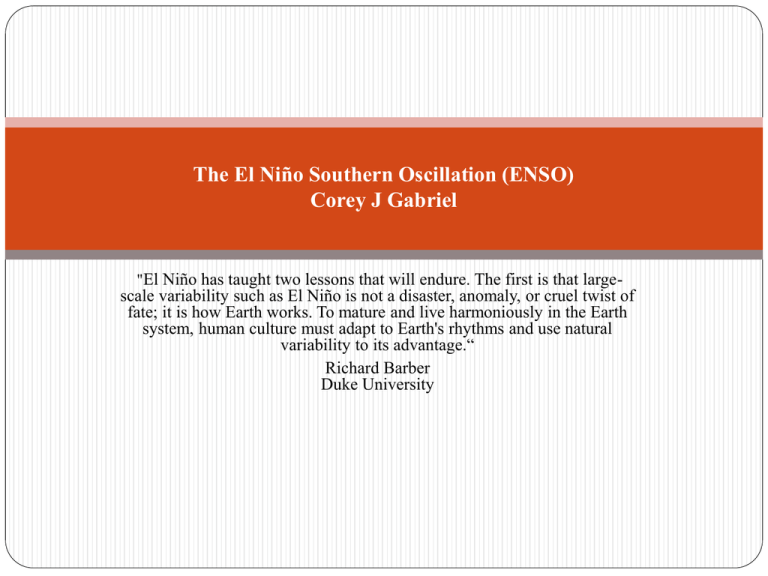
The El Niño Southern Oscillation (ENSO) Corey J Gabriel "El Niño has taught two lessons that will endure. The first is that largescale variability such as El Niño is not a disaster, anomaly, or cruel twist of fate; it is how Earth works. To mature and live harmoniously in the Earth system, human culture must adapt to Earth's rhythms and use natural variability to its advantage.“ Richard Barber Duke University The Walker Circulation Typical conditions: westerly trade winds across the Pacific, resulting in substantial upwelling, and intense convective towers in the western Pacific. The circulation closes with easterly winds aloft, and sinking air in the eastern Pacific. ENSO Events in the Equatorial Pacific Figure 3: The peak of a strong El Niño (warm) event from December 1997. Warm water, typically confined to the western Pacific, has spread east, towards South America (top panel). In response, the Walker Circulation has weakened, resulting in the cessation of westerly trade winds. Normally weak winds in the western Pacific are now strong easterly winds, which push warm water towards the East (bottom panel). Source: http://www.pmel.noaa.gov/tao/elnino Figure 4: The peak of a strong La Niña (cold) event from December 1998. Anomalously strong westerly trade winds advect warm water farther into the western Pacific. In response, robust upwelling occurs in the equatorial eastern and central Pacific. During the height of a strong La Niña event, SSTs along the equator may decrease by up to 4 °C. La Niña events typically have a duration of between 9 and 12 months. Source: http://www.pmel.noaa.gov/tao/elnino ENSO: Kelvin and Rossby Waves Walker circulation weakens. Tradewinds cease to pile up water in the west Mass surplus created near the equator Downwelling Kelvin Wave forced to propagate eastward with equator as wave guide (speed ~3m/s, 70 days to cross Pacific). Deepens thermocline, warms eastern Pacific Reflects westward as an upwelling Rossby Wave after reaching the eastern boundary. (speed~0.9m/s, 200 days to cross Pacific). This reverses the warming. This is a huge simplification: ENSO actually involves a long series of windstress anomalies Monitoring the El Niño-Southern Oscillation (ENSO): Figure 1: NINO regions in the equatorial Pacific. Source: http://iri.columbia.edu/climate/ENSO/backgroun d/monitoring.html Figure 2: Locations of moored buoys in the TAO Array. Source http://iri.columbia.edu/climate/ENSO/backgroun d/monitoring.html The ENSO phase impacts global temperature and precipitation patterns in remote regions of the globe through robust teleconnections. *Teleconnection pattern: a characteristic and persistent synoptic pattern that arises as a result of internal climate dynamics. *Changes in SST and precipitation patterns in the equatorial Pacific, as a result of the ENSO cycle, cause changes in the position and strength of the jet stream, altering storm tracks, as well as precipitation and temperature patterns across the globe. *Remote temperature and precipitation response are shown here. Teleconnection responses to an El Nino (warm) event and La Nina (cold) event are seasonally dependent. Source: linkingweatherandclimate.co m/ENSO/tele.php. Mean-State of ENSO in each CMIP3 Model: *General trend toward more uniform SST pattern across the Pacific, in experiments forced by a 1% per year increase in CO2 concentration. *A more El-Niño-like mean state may emerge, reflecting a general weakening of the tropical circulation.. *Negative feedbacks will tend to stabilize the western Pacific warm pool, while surface temperature and convection will increase across the central and eastern Pacific. Source: http://www.ipcc.ch/publication s_and_data/ar4/wg1/en/ch10s1 0-3-5-3.html References Barnett, T. P.D. W. Pierce, M. Latif, D. Dommenget, R. Saravanan, Interdecadal interactions between the tropics and midlatitudes in the Pacific basin, Geophys. Res. Lett., 26, 615–618, 1999. Lowell Stott, Christopher Poulsen, Steve Lund, and Robert Thunell Super ENSO and Global Climate Oscillations at Millennial Time Scales Science 12 July 2002: 297 (5579), 222-226. Trenberth, Kevin E., 1997: The Definition of El Niño. Bull. Amer. Meteor. Soc., 78, 2771–2777. Zebiak, Stephen E., Mark A. Cane, 1987: A Model El Niño–Southern Oscillation. Mon.Wea. Rev., 115, 2262–2278



